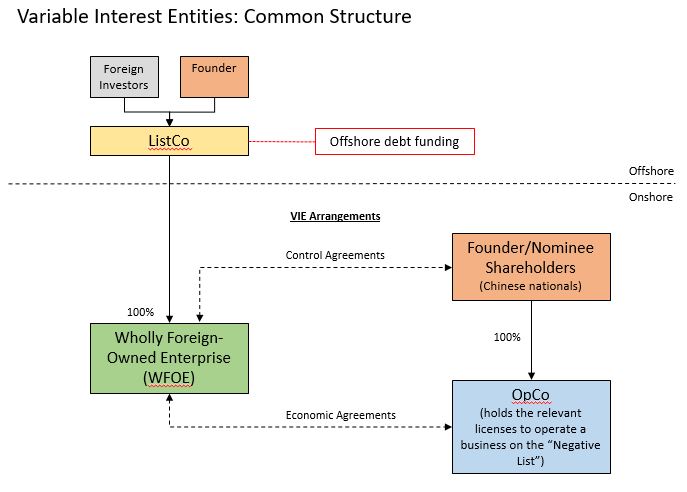New Mainland China Implementation Rules for the Law for Promoting Private Education – Implications for Investments into VIE Structures?

On May 14, 2021, the People’s Republic of China (PRC) State Council announced the Implementation Rules for the Law for Promoting Private Education (“Education Sector Implementation Rules”). These measures—which contain various detailed provisions on the operational and governance aspects of education—are part of China’s ongoing efforts to further regulate and streamline the provision of private sector education. The Education Sector Implementation Rules also effectively prohibit China-based foreign-invested enterprises and enterprises controlled by foreign parties from participating in the provision of compulsory education (being that provided in years K-1 to K-9 (“Compulsory Schooling”)) in mainland China (the “Mainland”) with effect from September 1, 2021. The Education Sector Implementation Rules also contain a prohibition, from the same date, on the use of mergers and acquisitions or contractual control arrangements in connection with Compulsory Schooling and the provision of pre-school (i.e., kindergarten) schooling (“Pre-Schooling” and together with Compulsory Schooling, “Restricted Education”).
Foreign ownership of education businesses was already restricted on the Mainland prior to the promulgation of the Education Sector Implementation Rules, as the education sector is on the so called “Negative List”1, along with other sectors such as internet, media and telecommunications. While the Negative List prohibits foreign investors owning businesses operating in Negative List sectors, foreign investments were often made through variable interest entity structures (“VIE Structures”), which provide investors with contractual control rights and the economic benefit of the investee business, but fall short of “ownership”.
The Education Sector Implementation Rules appear to be yet another example of the global trend toward greater scrutiny and restriction of foreign investment in strategically important or otherwise sensitive sectors. Other examples include the recently introduced National Security and Investment Act in the United Kingdom and the proposed expansion of the Committee on Foreign Investment in the United States.
In this update, we look at the use of VIE Structures on the Mainland, consider the potential implications of the Education Sector Implementation Rules for VIE Structures in the provision of Restricted Education, and consider the likely future of VIE structures on the Mainland.
What is a VIE Structure?
A VIE Structure facilitates foreign investment into Chinese companies that operate businesses in sectors on the Negative List through the use of contractual control and economic agreements. VIE Structures have been used by a number of well-known Chinese offshore-listed companies in a variety of sectors on the Negative List. VIE Structures are also used in a number of other countries in the Asian region, such as Thailand and the Philippines, in light of certain foreign ownership restrictions in those jurisdictions.
An example of a common VIE Structure is set out below:

As the above chart indicates, the offshore listed entity (ListCo) maintains its interest in the onshore operating company (OpCo) not through direct ownership (which is prohibited), but rather through a series of contractual control and economic agreements. The OpCo is typically owned by the Chinese founder of the group or by nominees (all of whom are required to be Chinese nationals). The object of these contractual arrangements is to enable the ListCo, through its onshore wholly foreign owned subsidiary (WFOE) to (i) maintain practical control over OpCo and its shareholders and (ii) receive the economic benefit of OpCo’s operations.
The contractual agreements typically include, among other things, (1) economic agreements in the form of management and service agreements pursuant to which the OpCo pays management and/or other service fees to the WFOE; and (2) control agreements in the form of share pledges (in respect of the shares in the OpCo), voting proxy agreements and powers of attorney from the Founder/Nominee Shareholders in favor of the WFOE, along with call options granted by the Founder/Nominee Shareholders to the WFOE in respect of the issued share capital in the OpCo.
Although the use of VIE Structures has been common since their introduction in the early 2000s, there has always been some uncertainty as to their legality and validity under PRC law. The relevant regulators on the Mainland have also appeared reluctant to formally approve or disapprove the use of such structures. That legal uncertainty has often been flagged as a risk factor in public offering documents for debt or equity investments into Chinese businesses structured as VIEs, but many foreign investors in the capital markets have, to date, been comfortable with investing in these structures, notwithstanding the risks.
In February 2021, the Antimonopoly Bureau of State Administration for Market Regulation (SAMR) published new guidelines to enhance its regulatory powers in respect of certain aspects of anticompetitive market behavior and merger-related activity. These new regulations also brought into clearer regulatory focus the use of VIE Structures in prohibited and restricted sectors of the economy, by clarifying that such structures—which are commonly used by internet and other technology platforms—do fall within merger control review and are now expressly subject to SAMR’s regulatory authority.
Key Implications of the Education Sector Implementation Rules
The Education Sector Implementation Rules, with their focus on the operational and governance aspects of education that are part of China’s ongoing efforts to further regulate and streamline the provision of private sector education, also target VIE Structures used in businesses operating in the Restricted Education sector. While the intent of the foreign ownership aspects of the Education Sector Implementation Rules is evident—to prohibit foreign ownership and/or control of such businesses—there are still some areas of uncertainty as to how and when the Education Sector Implementation Rules will be enforced against schools providing Restricted Education services that are funded and controlled through VIE Structures.
For example, it is not yet clear whether a grace period will apply after September 1, 2021, or if that will be enforced as a hard deadline. Nor is it clear precisely how the Education Sector Implementation Rules will be enforced by the PRC Ministry of Education. The possibilities, as some practitioners have speculated, might include the relevant PRC authorities directing noncompliant businesses to cease operations, or requiring such businesses to divest the Restricted Education aspects of their operations. This approach would, if adopted, obviously have far-reaching adverse implications for investors in VIE Structures in the Restricted Education sector who would arguably be forced to divest assets to onshore parties that are able to comply with the Education Sector Implementation Rules. It could also have serious implications for the listing status of the shares of affected offshore listcos operating via VIE Structures in the sector.
Debt issuers that hold their business through affected VIE Structures, as well as their bondholders and other lenders, will also need to keep their debt instruments under close review and consider whether the Education Sector Implementation Rules and/or their enforcement will trigger any adverse events under those documents, such as covenant breaches, events of default or mandatory redemptions and plan for those events accordingly.
The Outlook for VIE Structures on the Mainland
The promulgation of the Education Sector Implementation Rules signals a greater focus on the operational and governance aspects of education, as well as a potential tightening of control over foreign investment in certain prohibited and restricted sectors on the Mainland. Whilst only the education sector (specifically the Restricted Education segment) is currently affected by these rules, the market will be watching closely to see whether the increased focus on the Mainland on VIE Structures will result in similar rules being introduced over time in respect of other sectors of China’s economy in which foreign investment, ownership or control is prohibited or restricted. Until there is greater certainty on these issues, foreign investors that are considering investing via VIE Structures on the Mainland will need to give careful consideration to the risks of doing so in this evolving legal and regulatory landscape.
1 The various sectors and industries where foreign investment is prohibited or restricted (i.e., the Negative List) are set out in the Special Administrative Measures (Negative List Edition 2020) on Access to Foreign Investment (“National Negative List”) and Free Trade Zone Special Administrative Measures (Negative List Edition 2020) on Access to Foreign Investment (“FTZ Negative List”).



